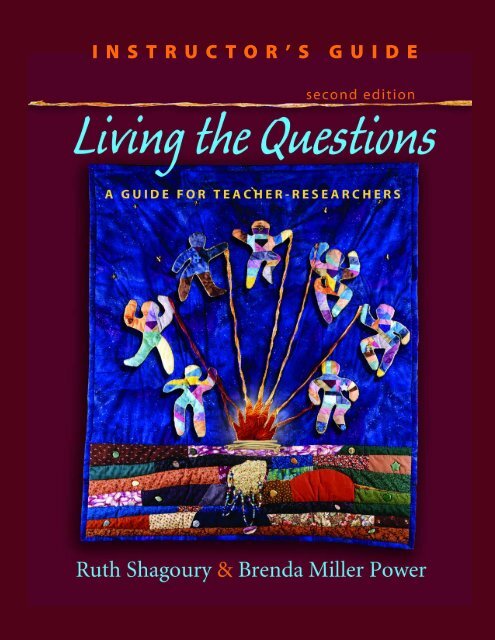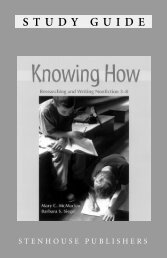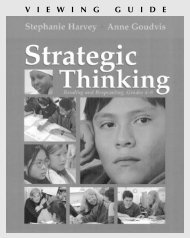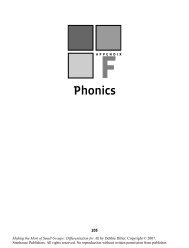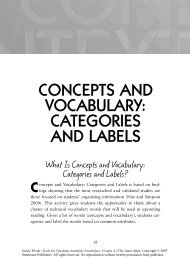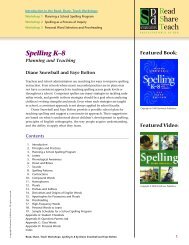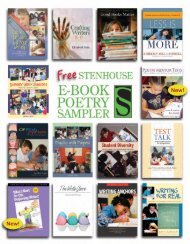Study Guide - Stenhouse Publishers
Study Guide - Stenhouse Publishers
Study Guide - Stenhouse Publishers
You also want an ePaper? Increase the reach of your titles
YUMPU automatically turns print PDFs into web optimized ePapers that Google loves.
I N S T R U C T O R ’ S G U I D E
Living the Questions<br />
2<br />
Instructor’s <strong>Guide</strong><br />
Using a Research Workshop Approach in College Courses<br />
or School Inservice Programs<br />
Teacher-researchers need a community in which to learn the tools of the trade, experimenting<br />
and talking through their processes as they work. College research methods courses<br />
and school inservice programs are where most teacher-researchers create this community;<br />
Living the Questions was designed for use in these settings.<br />
The mix of research strategies and tips, essays by teacher-researchers, and research workshops<br />
allows you to tailor your instruction to the needs of the educators you will be working<br />
with. We suggest a research workshop approach to instruction, as it will give the educators a<br />
framework for their continued work beyond the course. This guide will help you develop a<br />
research workshop approach in helping others become teacher-researchers and develop their<br />
own teacher-research communities.<br />
Course or Inservice Elements<br />
We’ve found it’s best to develop a set structure when you’re using a workshop approach in a<br />
research methods course. Regular routines foster more self-directed learning and responsibility<br />
for participants. Here is a sample structure for a course:<br />
2 1/2 Hour Format<br />
• Discussion of Reading Response Papers—45 minutes (see the following section)<br />
• Brief Presentation by Instructor and/or Students—30 minutes<br />
• Short Break<br />
• Research Workshops—60 minutes (using workshops within each chapter of Living the<br />
Questions)<br />
In order to use a workshop format, you need to prepare assignments in advance. Once you<br />
and your students become accustomed to a hands-on research approach, however, you will<br />
be delighted by how much responsibility shifts to students each week and how quickly students<br />
come to enjoy the variety of experiences. This guide to a research workshop course<br />
approach includes a full explanation of standard weekly assignments. Ten additional onepage<br />
assignments that you can tailor to your own teaching plans can be found at the end of<br />
this guide.<br />
Reading Response Papers<br />
One of the most useful weekly reading response activities is a one-page required response.<br />
Students use these reading responses in small groups (or with the whole group, if you are<br />
leading a small seminar). The response activity is simple. Participants distribute copies of<br />
their responses in small groups and skim all papers silently for the first ten minutes, highlighting<br />
different points they want to discuss with the whole group. Then, for twenty minutes,<br />
the small groups discuss each paper while a group recorder notes key points. The<br />
recorders report back to the whole class during a ten-minute whole-group discussion that<br />
closes the activity.<br />
The Reading Responses <strong>Guide</strong> Sheet for students is adapted from the work of Linda Rief<br />
in Seeking Diversity (1992). See Assignment 1 in this guide for a Reading Responses <strong>Guide</strong><br />
Sheet.<br />
Copyright © 2012 Ruth Shagoury and Brenda Miller Power. <strong>Stenhouse</strong> <strong>Publishers</strong>.
Living the Questions<br />
3<br />
Instructor’s <strong>Guide</strong><br />
Presentations on Themes<br />
We find presentations in a workshop are most successful if instructors follow a mini-lesson<br />
approach, presenting information in a way that is short, sharp, and focused. This is also a<br />
good time to bring in other teacher-researchers who have completed the course and gone on<br />
to produce successful work. Here are some potential presentations:<br />
1. Mini-lessons on specific aspects of the research process, such as:<br />
• Practice note taking. You might have participants test out writing “in the midst”<br />
or “after the fact” notes using video segments (three to five minutes from any<br />
classroom).<br />
• Experiment with interviews. Show excerpts of interviews you or other teacherresearchers<br />
have conducted. Encourage students to critique what seemed to work<br />
well and what could be improved. For a follow-up lesson you could ask students to<br />
brainstorm interview questions that would enhance their own research.<br />
• Write memos. This is a mini-lesson that can be done more than once in a term and<br />
helps students see the power of beginning to analyze their data during the process of<br />
collecting it. Ask students to take ten minutes to write about one thing they noticed<br />
this week that intrigued them: a finding, an observation, or a cluster of events. These<br />
memos can be shared with partners or small groups and revisited later in the course.<br />
• Find patterns. Using the classroom itself as a database can provide excellent opportunities<br />
for mini-lessons on data analysis. Patterns and categories can be charted in the<br />
themes of the weekly response papers, taped transcripts of small-group discussions,<br />
or other examples of student work generated within the research class itself.<br />
2. Your own teacher research—your own data, what you discovered, what you’d do<br />
differently.<br />
3. Individual teacher-researchers, or panelists—this works well if it’s repeated in the<br />
course to make different points. Some panelists early in the course might talk about<br />
research design; others later in the course might talk about the experience of presenting<br />
their work to a larger audience.<br />
4. Presentations by students on different aspects of their research process.<br />
Research Workshops<br />
Living the Questions includes numerous research workshops that can be used within a college<br />
course or an inservice program. Here is a sample schedule of workshops and readings for a<br />
twelve-week course:<br />
Week 1<br />
• Read the “Things I Learned” poems from the Research Workshop on pages 10–12 in<br />
Living the Questions.<br />
• Have each student write one line about what they learned about teaching this week and<br />
then write or read the lines as a collective class poem.<br />
• Assign “Hanging Around” (Assignment 2 in this guide); send students in teams to do<br />
the first “Hanging Around” observation in the last hour of class.<br />
• Workshop assignment for Week 2: Each student brainstorms five questions about<br />
teaching and brings the questions to the next class.<br />
• Reading assignment for Week 2: Chapters 1 and 2 in Living the Questions.<br />
Copyright © 2012 Ruth Shagoury and Brenda Miller Power. <strong>Stenhouse</strong> <strong>Publishers</strong>.
Living the Questions<br />
4<br />
Instructor’s <strong>Guide</strong><br />
Week 2<br />
• Discuss notes from the first “Hanging Around” observation.<br />
• Do the “How to Refine a Research Question” exercise (Assignment 3).<br />
• Reading assignment for Week 3: Chapter 3 in Living the Questions.<br />
Week 3<br />
• Have students present their group “Hanging Around” final projects to the whole class.<br />
• Have students brainstorm mini-inquiry projects for the week (see pages 74–76, “Testing<br />
the Water with Mini-Inquiry Projects,” in Living the Questions).<br />
• Reading assignment for Week 4: pages 91–115 of Chapter 4 in Living the Questions.<br />
Week 4<br />
• Have students circulate one- to two-page mini-inquiry project findings; discuss in<br />
small groups and with the whole class.<br />
• Brainstorm individual questions for sociogram interviews; the raw data collected<br />
during the week will be used in the following week’s workshop.<br />
• Reading assignment for Week 5: pages 115–133 of Chapter 4 in Living the Questions.<br />
Week 5<br />
• Do “How to Do a Sociogram Workshop” (Assignment 4).<br />
• Reading assignment for Week 6: Chapter 5 in Living the Questions.<br />
Week 6<br />
• Work in small groups to talk about possible formats/designs for individual case studies<br />
after handing out the “Case <strong>Study</strong>” sheet (Assignment 5).<br />
• Reading assignment for Week 7: Chapter 6 in Living the Questions.<br />
Week 7<br />
• Share and discuss drafts of case studies; assign “Case <strong>Study</strong> Role Plays” (Assignment 6)<br />
for next week.<br />
• Reading assignment for Week 8: Chapter 7 in Living the Questions.<br />
Week 8<br />
• Case studies due—for the first fifteen minutes of workshop, ask participants to “be”<br />
their case studies.<br />
• Assign the first draft of research briefs that will be due Week 10; encourage participants<br />
to reread research briefs in Chapter 3 of Living the Questions as well as the many examples<br />
in the Teacher-Research Designs appendix (pages 241–268).<br />
• Assign the “You’re Invited Dinner Party” (Assignment 7) for next week.<br />
• Reading assignment for Week 9: Teacher-Research Designs appendix.<br />
Week 9<br />
• Share dinner invitations and guest lists in whole group from the “You’re Invited”<br />
activity (Assignment 7); discuss the implications for literature review.<br />
• Assign “Preparing to Write a Literature Review” (Assignment 8) for next week.<br />
• Reading assignment for Week 10: Chapter 8 in Living the Questions.<br />
Copyright © 2012 Ruth Shagoury and Brenda Miller Power. <strong>Stenhouse</strong> <strong>Publishers</strong>.
Living the Questions<br />
5<br />
Instructor’s <strong>Guide</strong><br />
References<br />
Week 10<br />
• Share drafts of research briefs in small groups.<br />
• Have each participant write a letter to send to his or her favorite featured teacherresearcher<br />
from Living the Questions, to be due Week 11 (Assignment 9).<br />
• Reading assignment for Week 11: Epilogue in Living the Questions.<br />
Week 11<br />
• Share revised research briefs and letters to teacher-researchers in small groups; bring<br />
stamps and envelopes so students have the option of mailing their letters to teacherresearchers.<br />
• Reading assignment for Week 12: readings related to research brief topics.<br />
Week 12<br />
Final Research Briefs Due<br />
• Have a “Research Briefs” or “Research Findings” cocktail party or tea party. Bring party<br />
foods and nonalcoholic drinks, and require that students circulate in class, moving<br />
every few minutes to talk with someone else about their research plans. Their cocktail<br />
party chat must be focused on their research. Play soft music in the background. This is<br />
a great way to close out a college course or inservice program!<br />
We hope these formats and suggestions give you just enough information to get you<br />
thinking about how to develop your own unique workshop course tailored to the needs of<br />
your students.<br />
Kirby, Dan, and Carol Kuykendall. 1991. Mind Matters. Portsmouth, NH: Heinemann.<br />
Rief, Linda. 1992. Seeking Diversity. Portsmouth, NH: Heinemann.<br />
ASSIGNMENT 1<br />
Reading Responses <strong>Guide</strong> Sheet<br />
You will need to write a one-page, single-spaced response to one of the readings each week.<br />
These responses will serve as the basis for our discussions of the readings. You may choose to:<br />
• Analyze the Researcher’s Role<br />
What is the researcher’s method What ethics are involved in the decisions made in the<br />
study What differences do you see between your own beliefs and the beliefs informing<br />
the researcher’s work<br />
• Consider Methodology<br />
What choices are being made about what types of data are collected and analyzed<br />
What constraints does the researcher experience in data collection and analysis What<br />
would you do differently<br />
• React and Connect<br />
How does this reading connect with what we’ve read earlier What do you agree with in<br />
the reading What do you disagree with What provokes an emotional response<br />
Copyright © 2012 Ruth Shagoury and Brenda Miller Power. <strong>Stenhouse</strong> <strong>Publishers</strong>.
Living the Questions<br />
6<br />
Instructor’s <strong>Guide</strong><br />
• Ponder the Structure and Writing Style<br />
How does the researcher make the study come to life What are the “telling” details or<br />
incidents included What do you think is left out of the study You’ll need to have<br />
twenty copies of your written response to distribute to classmates in small groups at<br />
the start of class.<br />
Here are some tips to help instructors get the most out of this activity:<br />
1. As instructors, you’ll need to write a weekly one-page response that is distributed to all<br />
groups. This gives students a strong model, and it also allows you to have a “voice” in<br />
the small groups you don’t have time to visit.<br />
2. Be picky about that weekly one-page, single-spaced written requirement. Students will<br />
test the limits, double-spacing their work or skipping a week altogether. The activity<br />
falls apart quickly if everyone doesn’t participate equally in the writing responsibility.<br />
3. Avoid grading these one-pagers. The point is to get students to share their ideas freely<br />
and take a few risks in their writing. If you grade the papers, even with the dreaded<br />
“Check +” or “Check –,” students will try to make their writing fit the template of<br />
whatever has received the highest grade in the past.<br />
4. When assigning reading reactions, you could choose to be very specific about which<br />
section of a chapter you want students to write about. On the other hand, you might<br />
leave the response to a chapter open-ended, allowing participants to write about the<br />
sections that have the greatest impact on their thinking.<br />
5. If you have twenty students or less, you can build a classroom text through the reading<br />
reactions by having students bring copies for the whole class instead of a small group.<br />
In this case, workshop participants can save all of the papers from week to week and<br />
have access to a range of classroom responses to the readings. They can also use them<br />
as an additional data source within the class, finding patterns in their classmates’<br />
responses to one particular reading or categories across the entire course when they<br />
reread the complete set. This alternative also opens the door to more whole-group discussions<br />
on all of the papers.<br />
ASSIGNMENT 2<br />
Hanging Around (pages 72–74)<br />
Participant observation is more than a research methodology. It is a way of being,<br />
especially suited to a world of change. A society of many traditions and cultures can be a<br />
school of life.<br />
—MARY CATHERINE BATESON<br />
For this assignment, you will need:<br />
1. One or two research partners<br />
2. A good people-watching spot at the mall, a restaurant, or a retail store<br />
Begin in the classroom before you go to your chosen site. After you’ve identified where<br />
you want to do your research, answer these questions individually (from Mind Matters by<br />
Kirby and Kuykendall [1991]):<br />
1. Considering what you know about this place, product, or service, what do you expect<br />
to find<br />
2. How do you expect the place to be organized<br />
Copyright © 2012 Ruth Shagoury and Brenda Miller Power. <strong>Stenhouse</strong> <strong>Publishers</strong>.
Living the Questions<br />
7<br />
Instructor’s <strong>Guide</strong><br />
3. What types of clients or customers do you expect Will one age group or gender predominate<br />
Do you expect a certain income or educational level to dominate<br />
You and your partners should compare notes, highlighting differences in expectations.<br />
You will then go to watch people in the location of your choice. Your goal is to describe fully<br />
the scene, events, actors, and interactions. On site, start with the basic components of understanding<br />
the site by answering more of Kirby and Kuykendall’s questions:<br />
1. How many cars are in the parking lot<br />
2. What are the “arrival behaviors” of the customers (Do they pause to look in the<br />
window, or rush in; do they speak to other people What greetings do they use Do<br />
they ask for information etc.)<br />
3. Note the number of customers arriving alone and the size of groups. Keep a running<br />
tally of customers by age group, gender, and ethnicity.<br />
4. If possible, talk to one customer who doesn’t seem to be in a hurry. What brings the<br />
customer there How often What does he or she think of the place Ask similar questions<br />
of an employee about the clientele of the place. Set aside at least fifteen minutes<br />
to write down random observations of the site.<br />
Ask yourself these questions as you take notes:<br />
1. Who’s in charge How is power gained or lost as the actors interact<br />
2. Who controls conversations What are the topics of conversation<br />
3. What are the key elements in the scene<br />
4. What are the relationships of the actors<br />
5. What language or actions seem specific to the culture and the scene<br />
6. What ethical concerns arise from the assignment<br />
You and your partner(s) should take notes separately and then compare them. This<br />
activity will be repeated next week, with time in class for discussion of notes. Your final collective<br />
analysis (due at the fourth class session) should describe the scene, events, actors, and<br />
interactions fully in any form—narrative, poem, fiction, or role play. It should be no longer<br />
than three single-spaced, typed pages. You should also include a detailed map of the scene.<br />
ASSIGNMENT 3<br />
How to Refine a Research Question (pages 28–29)<br />
Start with four core principles:<br />
1. Ask only real questions. Don’t do research to confirm your good teaching practice.<br />
2. Avoid asking yes-or-no questions.<br />
3. Eliminate jargon.<br />
4. Avoid value-laden words or phrases. For example, your question might begin as:<br />
Do LD/ADHD students engage in meaningful discussions during literature circles<br />
The final answer to this question, a yes or no, won’t get at the key issues of how, why, and<br />
when these students are involved in talk. This question also gives the impression that you are<br />
setting out to prove a preconception—either you support certain students being in these<br />
groups, or you don’t.<br />
Copyright © 2012 Ruth Shagoury and Brenda Miller Power. <strong>Stenhouse</strong> <strong>Publishers</strong>.
Living the Questions<br />
8<br />
Instructor’s <strong>Guide</strong><br />
First, change the research question so that it is open-ended:<br />
What happens when LD/ADHD students engage in meaningful discussions during<br />
literature circles<br />
Next, underline any words that are jargon and rewrite them so that any reader could<br />
understand what you mean:<br />
What happens when LD/ADHD students engage in meaningful discussions during<br />
literature circles<br />
The definitions of LD (learning disabled) and ADHD (attention deficit hyperactivity disorder)<br />
are debated even among educators and would likely be unknown to a lay reader.<br />
Literature circle is a specific curricular innovation that is defined differently among teachers.<br />
The revised research question becomes:<br />
What happens when students identified with special needs engage in meaningful<br />
discussions during reading instruction<br />
While identified with special needs and reading instruction are much broader, they are<br />
terms any reader can understand, and they can still be defined more specifically in the actual<br />
study.<br />
Finally, underline and change any value-laden words that would require explanation for<br />
readers:<br />
What happens when students identified with special needs engage in meaningful<br />
discussions during reading instruction<br />
Part of the goal of this research will be to get at how you and your students define meaningful.<br />
This word needs to be cut from your research question so that the values you share<br />
with your students, and the values that might divide the classroom community, can emerge<br />
from the study.<br />
It is a terrific exercise for any researcher to consider the ideals lying beneath value-laden<br />
words. When refining your research question, try to brainstorm how you define words like<br />
meaningful, and ask students to define what makes a literature discussion meaningful. By ferreting<br />
out value-laden words in your research question and subquestions, you can begin to<br />
uncover your biases and preconceptions before the study begins.<br />
The final refined research question becomes:<br />
What happens when students identified with special needs engage in discussions during<br />
reading instruction<br />
ASSIGNMENT 4<br />
How to Do a Sociogram Workshop (pages 156–158)<br />
Sociograms are a useful source of information for analyzing the social networks in your classroom.<br />
What you need first is a question for individual interviews with your students that<br />
requires them to answer with the names of their classmates. For example:<br />
Copyright © 2012 Ruth Shagoury and Brenda Miller Power. <strong>Stenhouse</strong> <strong>Publishers</strong>.
Living the Questions<br />
9<br />
Instructor’s <strong>Guide</strong><br />
• If you could eat lunch with anyone, who would you sit next to<br />
• How do you know who is a good writer in this class<br />
• If you could read a book with anyone in the class, who would you read with<br />
Ideally, the question should have some link to your research topic, even if the link is weak.<br />
With younger students (grades pre–K–2), you or a colleague will need to interview each<br />
child separately in a space that’s slightly removed from the rest of the class. These interviews<br />
should be done very quickly—no more than a minute per student. Resist the urge to ask<br />
“Why” when a student gives a surprising response; those types of open-ended questions are<br />
useful for other aspects of your research, but not sociograms. With older students, you can<br />
pass out slips of paper and have each student immediately write a response to your question—this<br />
takes less than five minutes of class time.<br />
As you’re interviewing or after you collect the slips from students, you’ll need to do a tally<br />
sheet. To do the tally sheet, list the name of the person interviewed and the names of the<br />
classmates she or he lists as first, second, and third choices. For example, if you were interviewing<br />
Theresa, the tally sheet would look like this:<br />
Theresa<br />
1. Jennifer [her first choice]<br />
2. Kelly [her second choice]<br />
3. Melissa [her third choice]<br />
This would continue for the whole class:<br />
Harry<br />
1. Jim<br />
2. Joe<br />
3. Kelly<br />
and so on.<br />
Once you’ve completed the tally sheet, make a whole-class chart with names of students<br />
on horizontal and vertical margins. Give a child three points if he is the first choice of another<br />
student, two points if he is a second choice, and one point if he is a third choice. Add the total<br />
points for each child to get a sense of who has more social power in the class and who has less<br />
(with a positive question, students with the most points are those who have the most social<br />
power in the class, and those with the least points have the least).<br />
Many times it’s helpful to ask two questions—one from a positive social perspective and<br />
the other from a negative social perspective: “Who would you want to sit with at lunch” and<br />
“Who would you not want to sit with at lunch” When you have the negative data, you can<br />
differentiate between children who aren’t noticed by classmates and those who are disliked or<br />
avoided. For example, a student who has few points for each question for some reason is not<br />
visible to classmates. A student who has low points for the first question and high points for<br />
the second is behaving in a way that has a negative effect on his or her social status. If you<br />
have the time, you might want to chart your findings for the question, but many teachers save<br />
time by only adding up the tally points.<br />
Sociograms never stand alone as a data source. The results need to be triangulated with<br />
other data sources in order to provide truly valid findings. But if you’re stymied in trying to<br />
understand links between the social networks in your classroom and the learning going on,<br />
sociograms can provide a terrific quick look at complex social relationships. Some teacherresearchers<br />
avoid sociograms because they are concerned about hurt feelings if students share<br />
their choices with each other. We have not found this to be an issue with many teachers who<br />
have used sociograms, but we respect that concern.<br />
Copyright © 2012 Ruth Shagoury and Brenda Miller Power. <strong>Stenhouse</strong> <strong>Publishers</strong>.
Living the Questions<br />
10<br />
Instructor’s <strong>Guide</strong><br />
ASSIGNMENT 5<br />
Case <strong>Study</strong><br />
For your case study in this class, you will need to do a close examination of one student. The<br />
case study should be linked to the topic you want to explore in your research project. This<br />
can be a student of any age and any ability. You will need to gather the following materials:<br />
1. Work samples from a variety of contexts (writing samples, science reports, informal or<br />
formal assessments, etc.).<br />
2. Answers to interview questions. You will devise your own interview based on your<br />
research question. For example, if you were studying the effect of implementing science<br />
logs on students’ concepts of science, you might ask:<br />
• What do you like about the science program Why<br />
• Who is a good scientist that you know What makes him or her a good scientist<br />
• Why do we write during science time<br />
• What do you do well as a learner (or as a student in this class)<br />
• What do you do poorly as a learner (or as a student in this class)<br />
• What is science for<br />
• What could you do to improve your work in science<br />
You can develop questions of your own based on the age or needs of your case study or<br />
the direction the interview takes.<br />
3. Observations of your case study in class. Sit and observe your case study, and write<br />
down what you notice. What is his or her process Write rapidly, noting even trivial<br />
details. Try to do at least three ten-minute observations before you write up your case<br />
study. Please bring some of these materials (work samples, interview answers, and at<br />
least one of the ten-minute observations) to the next class. You will eventually write up<br />
your case study report as a three- to four-page, double-spaced, typed narrative.<br />
ASSIGNMENT 6<br />
Case <strong>Study</strong> Role Plays<br />
Next week, you will “be” your case study student for fifteen minutes in a class discussion. You<br />
should try to adopt the language style, body posture, tics, and persona of your case study<br />
during the class discussion. I will lead the discussion, asking the class these questions:<br />
• What do you like about school<br />
• What do you dislike about school<br />
• If you could say one uncensored thing to your teacher, what would it be<br />
• If you could say anything you want to your parents, what would you say<br />
• What does someone need to know about you in order to be able to teach you<br />
You’ll need to try as best you can to mimic the physical behaviors, speech patterns, and attitudes<br />
of your case studies. After these role-play discussions, we’ll talk as a whole group about<br />
the experience of trying to get into your case study’s skin.<br />
Copyright © 2012 Ruth Shagoury and Brenda Miller Power. <strong>Stenhouse</strong> <strong>Publishers</strong>.
Living the Questions<br />
11<br />
Instructor’s <strong>Guide</strong><br />
ASSIGNMENT 7<br />
“You’re Invited” Dinner Party (pages 178–180)<br />
Finding other researchers who can inform your research often begins with determining the<br />
essential issues in your research question. One way to do this is to imagine how others from<br />
widely varying disciplines would discuss your research question—this is an unusual way to<br />
gain multiple perspectives on your work. The “dinner party” assignment moves us into<br />
thinking creatively about how to figure out what other research and ideas should be incorporated<br />
into a project. More important, it emphasizes the value of building a research community<br />
while you build a base of readings to use in your work. As you bring different<br />
perspectives into framing your research question, it helps to think about individuals and<br />
wider communities that might inform your research design and plan in new ways. You can<br />
start by creating a dinner party guest list of people who could help pursue your research<br />
question.<br />
The instructions for the assignment are simple:<br />
1. Invite a minimum of six guests.<br />
2. The guests can be anyone—dead, alive, even fictional.<br />
3. For each guest, state your reason for inclusion and what you think or hope he or she<br />
would contribute.<br />
4. Be as creative as you like.<br />
For more information on this assignment (and examples), see “You’re Invited” by<br />
Kimberly Campbell, pages 178–180 in Living the Questions.<br />
ASSIGNMENT 8<br />
Preparing to Write a Literature Review (pages 180–186)<br />
In her first home each book had a light around it,<br />
The voices of distant countries<br />
Flooded in through open windows,<br />
Entering her soup and her mirror.<br />
—NAOMI SHIHAB NYE<br />
One way to approach a literature review is to find “mentor texts”—texts written by<br />
researchers whose questions, findings, and style of writing speak to you. For this assignment,<br />
you will pick one literature review and analyze it as a mentor text for your own research. For<br />
each text, answer teacher-researcher Jessica Singer Early’s questions:<br />
1. How does the argument unfold<br />
2. How does the author present two or more opposing schools of thought<br />
3. How does the author use model phrases or templates for sentences that serve as different<br />
transitions or functions<br />
4. How does the author evaluate (and not just list) what he or she is reading<br />
5. How does analyzing the literature review change the way you’ll approach reviewing the<br />
literature for your research<br />
Next week, bring in the literature review and your one-page analysis to share with others.<br />
Copyright © 2012 Ruth Shagoury and Brenda Miller Power. <strong>Stenhouse</strong> <strong>Publishers</strong>.
Living the Questions<br />
12<br />
Instructor’s <strong>Guide</strong><br />
ASSIGNMENT 9<br />
Letters to Teacher-Researchers (pages 220–223)<br />
How strange that we, as teachers, are asked to share our knowledge with students, but are<br />
rarely asked to share our knowledge with each other. Having the opportunity to read what<br />
other teacher researchers have written—and responding in a personal letter—was eyeopening<br />
for me. I was recently asked to write and publish some of the work my team and I<br />
are involved in, but my greatest concern was, “Who will read this and what do they care”<br />
Yet now I know that someone out there will read it, and hopefully can find some useful<br />
thread to adapt to her classroom.<br />
—CINDY QUINTANILLA<br />
As we look for communities to help sustain our work, we can reach beyond our immediate<br />
local and regional networks and discover teacher-researchers who share our interests,<br />
research passions, and classroom tensions. We can also take it a step further and communicate<br />
with those distant colleagues, expanding our communities and supporting each other<br />
beyond geographic boundaries.<br />
We have found that there are many benefits to taking the time to sit down and write to<br />
the teacher-researchers who have influenced our thinking or motivated us to make significant<br />
changes in our classrooms based on their research and classroom stories. The authors<br />
who receive the letters clearly benefit, too, of course; as Cindy notes, it is important for<br />
teacher-researchers to realize that their work and words have reached an audience, that their<br />
ideas have found a mark and made a difference.<br />
Teachers we know have written letters to teacher-researchers for a variety of reasons,<br />
often to thank them for their work and respond to their research on a personal level. Other<br />
times, the letters are a chance to share ideas and insights with a distant colleague who might<br />
be able to act as a sounding board or offer further resources.<br />
Teachers who received letters back from teacher-researchers they’ve written to have said<br />
it helps them realize that the authors are teachers like themselves, not magical beings. The<br />
work any teacher-researcher does in the classroom has the potential to expand beyond the<br />
borders of his or her school and community.<br />
Letter writing has a certain magic to it, and even if you ultimately decide not to mail your<br />
letter, you will benefit from the increased engagement with the research that has had an<br />
impact on you. It’s really quite easy to correspond with any author in print: simply write in<br />
care of the publisher or journal, and they will forward your letter to the author.<br />
Your assignment: Write a letter to any teacher-researcher. It should be a letter you feel<br />
comfortable sharing, since you will bring it to the group next week. (For examples of letters<br />
to teacher-researchers, see “Letters to Teacher-Researchers,” pages 220–223 in Living the<br />
Questions.)<br />
Copyright © 2012 Ruth Shagoury and Brenda Miller Power. <strong>Stenhouse</strong> <strong>Publishers</strong>.


